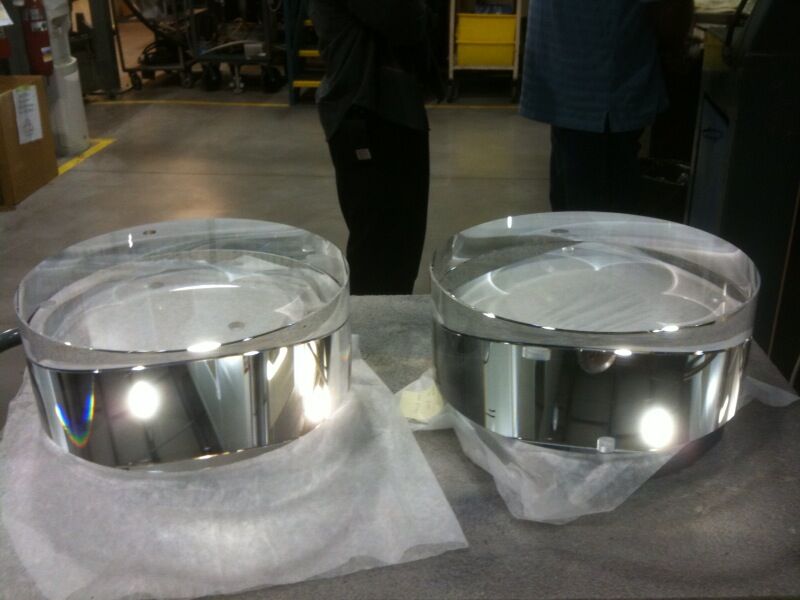
Quantum effects are generally thought of as small and fragile. Typically, we're only able to detect them when things are tiny and kept near absolute zero, and they're swamped by non-quantum effects outside of those conditions. Mostly. In Wednesday's issue of Nature, researchers are reporting that quantum effects can be detected in some very large objects: the 40kg mirrors of the Laser Interferometer Gravitational-Wave Observatory, or LIGO.
The paper details how researchers were able to detect noise in the mirrors of LIGO caused by quantum fluctuations in the light reflecting off them. And by adding some specially prepared light, the researchers limited that noise, allowing increased sensitivity in the detection of gravitational waves.
Putting on the squeeze
There are plenty of sources of noise in the LIGO hardware. Key hardware sits inside a vacuum chamber, but we can't really eliminate all stray molecules from bumping into it. The mirrors are kept at room temperature, so there's some thermal noise that's always interfering with our measurements. And then there's quantum noise. LIGO is based on mirrors separated by kilometers reflecting laser beams back and forth multiple times. And those laser beams are composed of photons that obey the rules of quantum mechanics.
In this case, the issue is the measurement of the light, which forms an interference pattern that will shift subtly if the lasers have been altered by a passing gravitational wave. But that same light is also influenced by quantum fluctuations in space itself. These fluctuations create a source of noise that limits the precision of the instrument's measurements and thus limits our ability to detect gravitational wave events.
The key to limiting this noise is the Heisenberg Uncertainty Principle, which dictates that there are limits to how well we can know the properties of quantum objects. Thus, we can't tell the position of these photons beyond a certain limit, because they're constantly fluctuating around a range of values.
But there is a way around Heisenberg. Certain quantum properties can be correlated, in which case the uncertainty limits the combined values of these properties. If you accept a lot of noise in one of the properties, you can get a lot more precision in your measurements of the other. Famously, this applies to location and momentum: if you want to know more precisely where a particle is, you can do so by sacrificing precision about its momentum.
But location and momentum aren't the only properties that can be correlated. In this case, the researchers relied on correlations between the amplitude of the light waves and their phase. By manipulating one, they could decrease the uncertainty in the other.
Vacuum squeezer
Those correlations occur naturally in the light within the LIGO instrument. As it bounces back and forth between the two mirrors, it exerts a force called radiation pressure on the mirrors. This process induces a correlation between the amplitude and phase of the photons that have been inside the instrument. The phase, in turn, is critical for creating the interference pattern that registers the passing of gravitational waves.
To use this correlation to squeeze down the quantum noise, the researchers manipulated the amplitude of light by using what's called a squeezed vacuum. In this state, the average amplitude of the light is zero, but the phase and amplitude can still be manipulated, allowing one of these properties to be squeezed. The squeezed vacuum was directed into the instrument, where it interacted with a critical mirror—one that was also interacting with the squeezed photons coming out of the instrument itself.
As a control, the researchers ran the setup without the squeezed vacuum, which provided a baseline reading of the noise from all sources. They then injected the squeezed vacuum into the instrument, trying varying degrees of squeezing of its amplitude and phase. This resulted in a lower total noise, and their measurements showed that the noise was sensitive to the properties of the squeezing. By altering these properties, they were able to shift the minimum to different frequencies of noise, increasing LIGO's sensitivity to specific classes of events.
This result is significant in a number of ways. For one, the differences in noise were dependent upon the interactions between light and a 40 kilogram mirror residing at room temperature. This doesn't mean that the mirror was behaving as a quantum object or had been entangled with the light. But it does mean that we can measure the effect that quantum interactions have on the physical motion of a large object sitting at room temperature.
This has a couple of interesting consequences. For one, this is the first time that researchers have managed to escape the limit placed on a system by quantum uncertainty in a setup like this. It also means that the researchers have altered the quantum properties of light without destroying the information it contains.
While both of those accomplishments are significant from the perspective of understanding quantum mechanics, the reduction in noise is also critical to operating the equipment. "During the third observing run of LIGO/Virgo, the squeezing angle in LIGO is set to optimize the sensitivity of the detectors to gravitational waves from binary neutron star mergers," the authors write. "This is one of the factors that has allowed Advanced LIGO to go from detecting roughly one astrophysical event per month in observing runs 1 and 2 to about one astrophysical trigger per week in the third observing run of LIGO/Virgo."
Nature, 2019. DOI: 10.1038/s41586-020-2420-8 (About DOIs).
"light" - Google News
July 02, 2020 at 09:16PM
https://ift.tt/2Bw8V9d
LIGO is so sensitive it shudders with the quantum noise of light - Ars Technica
"light" - Google News
https://ift.tt/2Wm8QLw
https://ift.tt/2Stbv5k
Bagikan Berita Ini














0 Response to "LIGO is so sensitive it shudders with the quantum noise of light - Ars Technica"
Post a Comment